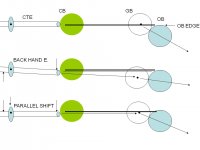Folks:
I think some of the issues we're overlooking here -- and I think CJ may agree with me because of his experience with snooker instruction -- are these points:
- Aiming at center pocket on *pool* equipment can lead to "laziness" in whether you're really hitting what you're aiming at. If you're not paying attention that you missed the center of the pocket, that "sloppage" in the abyss of pool equipment's pockets may go unnoticed -- and depended upon -- if you let it.
- CJ's "touch of inside" technique -- which pushes all that "sloppage" to one side of the pocket -- forces you to be more accurate. If you miss on the wrong side of the pocket (i.e. you get too fat of a hit), you will either knuckle the ball, or rail it. That's one way to "force" being more accurate with your aim, but it ain't the only one.
- Other cue sports don't have the plethora of alternative aiming techniques as pool does, because the focus is placed where it should be -- the center of the pocket, and the equipment won't let laziness rear its ugly head.
Take snooker, for example. If you get lazy, there is no pocket slop that "you can get away with." If you get lazy, you pay the price RIGHT THEN AND THERE with a miss. However, in pool, you can get "progressively lazy" -- where the pocket slop conceals the fact you missed your target, but you scored anyway. After a while, that "reliance" on the pocket slop increases, until you're at the bounds of the pocket itself, and now it's merely "send the object hither at the general direction of the pocket, and it 'should' score" -- which we all know, will bite your *ss.
I'm working with CJ's technique, but more for expanding my knowledge of throw and swerve, as well as the characteristics of my individual stroke. It's actually a hoot to play with, and I thank CJ for introducing it!
But I personally am going to continue to aim at a target that is a "pocket within a pocket" so-to-speak. I aim at a snooker pocket within the pool table's pockets, and I can immediately tell whether I hit my mark, because the space on both sides of the object ball as it enters the pocket doesn't lie.
-Sean
